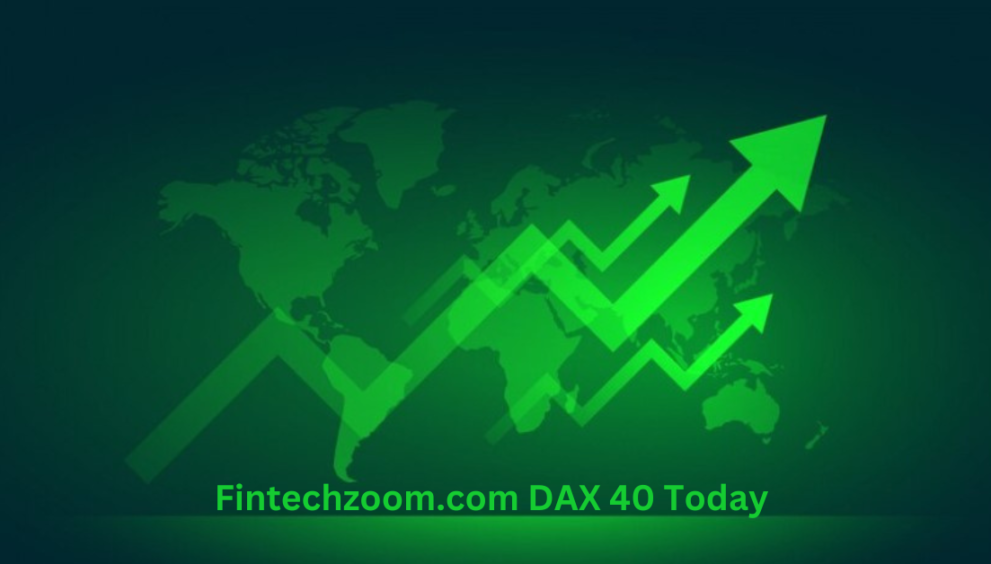Fintechzoom.com DAX 40 Today: A Comprehensive Guide

The DAX 40 (formerly known as the DAX 30) is one of the most important stock indices in Europe, reflecting the performance of 40 of the largest and most liquid companies on the Frankfurt Stock Exchange. Often regarded as a barometer for the German economy, the Fintechzoom.com DAX 40 Today is essential for investors who want to keep a finger on the pulse of the financial markets. With the growing significance of online financial platforms like FintechZoom, understanding the DAX 40 today can provide investors with real-time data, insights, and forecasts that help shape investment strategies.
In this article, we will break down the essentials of the DAX 40, explore its latest trends, and guide you through the tools and resources available on FintechZoom that allow investors to stay ahead in this ever-evolving market.
What is Fintechzoom.com DAX 40 Today?
The Fintechzoom.com DAX 40 Today, short for Deutscher Aktienindex, is a stock index that represents 40 of the largest companies listed on the Frankfurt Stock Exchange based on market capitalization and liquidity. Initially introduced in 1988 as the DAX 30, the index expanded in September 2021 to include ten additional companies, bringing the total to 40. This move aimed to improve the diversity and breadth of the index, offering a more comprehensive snapshot of the German economy.
Some of the well-known companies listed on the DAX 40 include global giants such as Siemens, Volkswagen, SAP, Bayer, and Deutsche Bank.
Why Was the DAX Expanded from 30 to 40?
The decision to expand the DAX from 30 to 40 was primarily motivated by the need to offer better diversification and stability in the index. By increasing the number of companies, the index now covers a broader range of industries and sectors, making it less susceptible to volatility in any one specific area. The change has made the DAX 40 more comparable to other major indices like the S&P 500 or FTSE 100, which track a broader range of companies.
How the DAX 40 Impacts Global Markets
As the German economy is the largest in Europe and the fourth largest in the world, the performance of the DAX 40 can have significant global implications. When the DAX 40 performs well, it often indicates confidence in the German economy and can inspire similar market trends in Europe and beyond. Conversely, a poor performance in the DAX 40 can ripple through global markets, particularly those in Europe.
Given Germany’s strong ties with industries such as automotive, pharmaceuticals, engineering, and finance, the DAX 40 acts as a barometer for the health of these sectors. Additionally, because many DAX-listed companies have operations around the world, the index’s movements can reflect broader trends in international trade and commerce.
Key Components of the DAX 40
To gain a comprehensive understanding of the DAX 40 today, let’s explore some of its key components. The DAX 40 comprises companies from diverse sectors, including:
- Automotive: Germany is home to some of the world’s most renowned car manufacturers. Companies like Volkswagen, BMW, and Daimler (now Mercedes-Benz Group) are all significant components of the DAX 40, and their performance is closely watched by investors.
- Technology: As technology continues to play a pivotal role in global markets, companies like SAP, a leader in enterprise software, represent the tech sector within the DAX.
- Pharmaceuticals: With the rise of healthcare investments, pharmaceutical giants such as Bayer and Merck are prominent players in the index.
- Finance: Major banks like Deutsche Bank and Allianz provide financial services that are crucial to the European and global economy.
These companies, among others, make up the backbone of the DAX 40 and contribute to the overall health of the index.
Tracking DAX 40 Performance on FintechZoom
For investors seeking the latest updates and data on the DAX 40, FintechZoom is an invaluable resource. FintechZoom offers real-time market data, insightful commentary, and expert analysis on the movements of the DAX 40.
Here’s how you can utilize FintechZoom to stay updated on DAX 40 performance:
- Real-Time Charts and Data
FintechZoom provides interactive charts that allow investors to track the performance of the DAX 40 minute-by-minute. This real-time data is essential for those looking to make quick investment decisions based on the latest market movements. - News and Analysis
Stay informed with the latest news on companies within the DAX 40. FintechZoom covers breaking stories, earnings reports, and key financial updates, all of which help investors gauge the health of the index. - Expert Opinions and Insights
FintechZoom offers in-depth analysis and expert opinions on the DAX 40, helping investors understand the factors driving the index and offering insights into potential future movements. - Historical Performance Data
Investors can access historical data on the DAX 40 to analyze trends over time, allowing them to spot patterns and make more informed decisions.
Latest Trends in the Fintechzoom.com DAX 40 Today
As of today, the DAX 40 is influenced by various global and local factors. These include the economic policies of the European Central Bank (ECB), supply chain disruptions, and the broader economic impact of geopolitical tensions, such as the ongoing war in Ukraine.
Geopolitical Tensions
Several German companies with ties to Russian energy supplies have faced challenges, which has influenced the performance of the index. Additionally, Germany’s role in the European Union places it in a central position in terms of economic sanctions and policies, which further impacts DAX-listed companies.
Inflation and Interest Rates
Another factor driving the DAX 40 today is the inflationary environment in Europe. Rising costs of raw materials, combined with supply chain disruptions, have led to increased prices for goods and services. The European Central Bank has responded by raising interest rates, which has influenced the performance of various sectors within the DAX 40, particularly the financial and real estate sectors.
Transition to Renewable Energy
The German government has been a strong advocate for the transition to renewable energy, and this trend is reflected in the DAX 40, with companies in the renewable energy space experiencing growth. Investors are paying close attention to how Germany’s energy policies influence the index, especially in light of the global push for sustainability.
Why Monitoring DAX 40 is Crucial for Investors
For both institutional and retail investors, the DAX 40 offers several key advantages:
- Economic Barometer: As previously mentioned, the DAX 40 is a reflection of the German economy. By monitoring the index, investors can get an idea of how well key industries in Germany are performing and adjust their portfolios accordingly.
- Diversification: The DAX 40 includes companies from various sectors, which provides diversification for investors who are looking to minimize risk.
- Global Reach: Many companies listed in the DAX 40 operate on a global scale. By investing in the DAX 40, investors can gain exposure to international markets.
- Liquidity: Due to the large size and liquidity of the companies within the DAX 40, it is easier for investors to buy and sell shares without worrying about drastic price changes.
How to Invest in the DAX 40
Investing in the DAX 40 can be done in several ways:
- Exchange-Traded Funds (ETFs)
One of the most popular ways to invest in the DAX 40 is through ETFs. These funds track the performance of the index and allow investors to gain exposure to all 40 companies within the DAX without having to buy individual shares. - Individual Stocks
For investors looking to focus on specific companies within the DAX 40, buying individual stocks is an option. This allows for more control over one’s portfolio, although it requires careful research. - Contracts for Difference (CFDs)
CFDs are another way to trade the DAX 40. These financial instruments allow investors to speculate on the movement of the index without having to own the underlying assets.
DAX 40 Forecast: What Lies Ahead?
Looking ahead, the future of the DAX 40 will likely be shaped by several key factors:
- Economic Recovery
As the world recovers from the economic impact of the COVID-19 pandemic, the DAX 40’s performance will closely reflect how quickly industries like automotive, pharmaceuticals, and manufacturing bounce back. - Technological Advancements
With companies like SAP leading the way in technology, the DAX 40 is well-positioned to benefit from advancements in areas such as artificial intelligence, cloud computing, and digital transformation. - Sustainability Initiatives
Germany’s commitment to sustainability and renewable energy will play a critical role in shaping the future of the DAX 40. Investors can expect to see increased investments in green energy, which will likely impact companies within the index.
Conclusion
Fintechzoom.com DAX 40 Today remains a key player in the global financial markets, offering investors valuable insights into the German economy and access to some of the world’s most influential companies. By utilizing platforms like FintechZoom, investors can stay up to date with the latest trends, real-time data, and expert analysis on the DAX 40. Whether you are a seasoned investor or just starting, keeping an eye on the DAX 40 today can help you make more informed decisions and stay ahead in the fast-paced world of finance.
FintechZoom provides the tools you need to navigate this complex landscape, offering everything from real-time charts to in-depth analysis—all designed to keep you informed and ready to take action.







